Folk remedies for a better harvest of cucumbers: recipes for fertilizing for open ground
When growing cucumbers, in addition to regular watering, pinching and prevention diseases, the summer resident is required to apply fertilizing. After all, only in rich soil will healthy plants grow, which will delight you with high yields.
Horticultural markets offer a huge selection of fertilizers for cucumbers. Most of them are made with the addition of chemical components and, while increasing plant productivity, reduce their environmental friendliness. Therefore, responsible gardeners prefer homemade recipes to store-bought preparations.
Signs of nutritional deficiencies
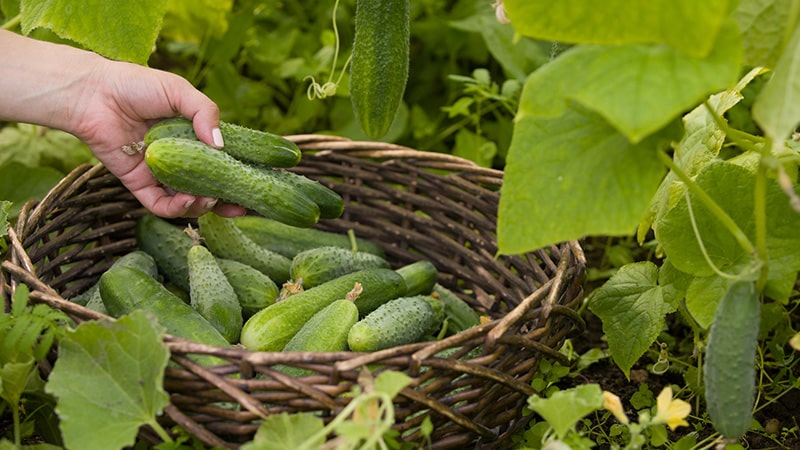
Feeding cucumbers in open ground using folk remedies is a must if you want to get an early and rich harvest. Nutrients are needed for the formation of ovaries and fruit formation. Cucumbers cannot independently extract all the necessary compounds from the soil at great depths due to their superficial root system.
It is recommended to fertilize cucumbers at least twice a season. If the soil is initially poor, an increased amount of fertilizing is applied.
Lack of nutrients affects not only the yield of cucumbers. When there is a nutritional deficiency, plants' immunity decreases, and infections affect them much more often.
If cucumbers lack any element, they begin to get sick:
- With a lack of nitrogen, the leaves become light and small. The tip of the fruit also brightens, narrows and bends. Nitrogen fertilizers include “green” fertilizers.
- With potassium deficiency, the edges of the leaves appear burnt. They become brown and dry, and the fruits become spherical and watery. One of the options for potash fertilizers is wood ash.
- With a lack of phosphorus, the leaves begin to grow upward. The deficiency of this microelement can be compensated by spraying the bushes with an ash solution.
- During magnesium starvation, the leaves acquire a “marbled” color - a web of light lines appears on them.
- If there is a lack of other microelements, the leaves turn yellow-green. This usually happens in the absence of foliar feeding.
Optimal time for fertilizing
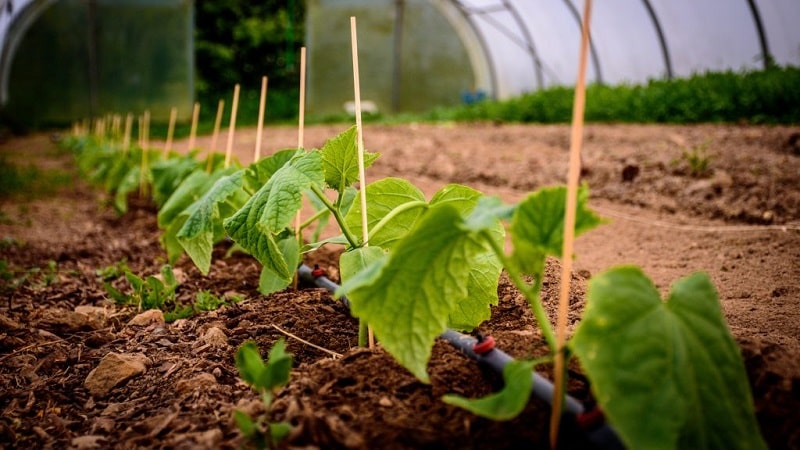
Experienced gardeners use the following fertilizing scheme:
- First time - at the stage of growing seedlings, 2 weeks before planting in open ground. Use no more than 1 liter of solution per 1 m².
- Second time Fertilizers are applied 10-14 days after picking into open ground. Up to 3 liters of product are used per 1 m².
- During the period of active flowering and formation of ovaries, a third feeding is applied.. At this stage, the amount of fertilizer increases to 5 liters per 1 m².
- During fruiting the soil is fertilized a fourth time. For 1 m² of planting, 7 liters of nutrient mixture are used.
- Last time - 2 weeks after the previous feeding.
More fertilizing is applied only if the plant shows signs of deficiency of any compounds. In nutritious soils, the introduction of a second and final fertilizing is not necessary.
Rules for applying fertilizing
Often the cause of decreased yields and plant diseases is improper application of fertilizers. This is due to the fact that saturated mixtures are used to enrich the soil composition.If used incorrectly, or if there is an excess of substances, they negatively affect the root system of cucumbers.
There are a number of rules for feeding cucumbers. Let's look at them in detail.
Applying fertilizers at the roots
Most fertilizers are applied at the roots. Be sure to use solutions to speed up the flow of substances through the root system.
It is important to follow a number of rules:
- The interval between feedings is at least 2 weeks.
- The day before fertilizing, water the plantings thoroughly. It is convenient to feed cucumbers after rain. Otherwise, the nutritional composition will burn the root system.
- It is recommended to alternate organic compositions with mineral ones.
- No more than two nitrogen fertilizers are applied per season. They lead to abundant formation of green mass. With an excess of nitrogen, few fruits are formed.
- Fertilizing is applied when the sun is inactive: early in the morning, at sunset, on cloudy days. Fertilizers make plants more sensitive to the sun.
- All fertilizers are applied to the roots in the form of a solution. Plants absorb nutrients only in this form.
- After picking, fertilizers are applied no earlier than 2 weeks later, otherwise the cucumbers will not take root well.
Foliar feeding
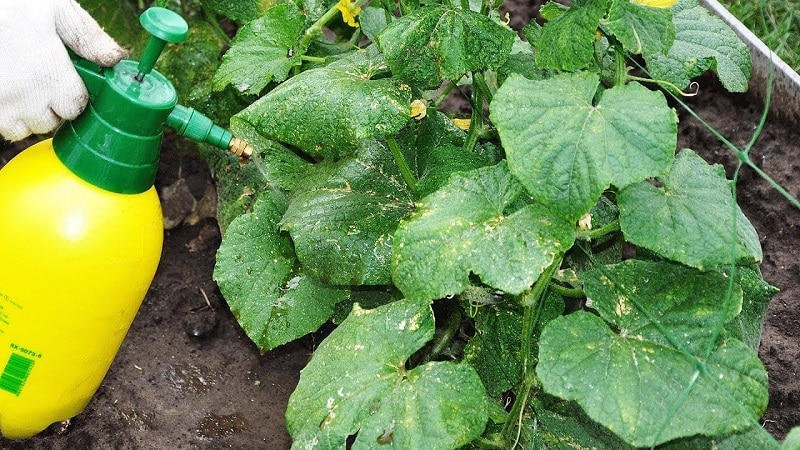
Foliar feeding involves spraying the bushes with nutritional compounds. In this case, trace elements penetrate the plant through its greenery.
Cucumbers are fed when signs of nutrient deficiency occur.
Some gardeners do this routinely:
- at the beginning of flowering;
- during the period of fruit ripening;
- at the end of fruiting.
Here are some tips for treating plants:
- The dose of the nutrient composition for spraying is two times less than for applying under the root.
- Plants are fed when the sun is inactive.Otherwise, burns will form on the leaves.
- It is important that the fertilizer is not washed off the plant within two hours after spraying. This time is enough for microelements to penetrate into the ground part.
- Each new remedy try first on one bush. If after a day the plant looks healthy, all plantings are sprayed.
Benefits of fertilizers without chemicals
Before feeding cucumbers in the open ground with folk remedies for growth, familiarize yourself with the advantages of this method:
- Saving. For most homemade fertilizers, the ingredients are not purchased, but are made from waste materials.
- Environmental friendliness. Homemade fertilizers do not contain harmful substances, which allows you to grow an environmentally friendly product.
- Safety. Overdose with folk remedies is less likely than with chemicals.
Folk recipes for feeding cucumbers
There are a huge number of folk recipes for feeding cucumbers. They use medicines, food waste, and livestock waste products. Among the variety of fertilizers, each gardener will choose the appropriate option.
Ash
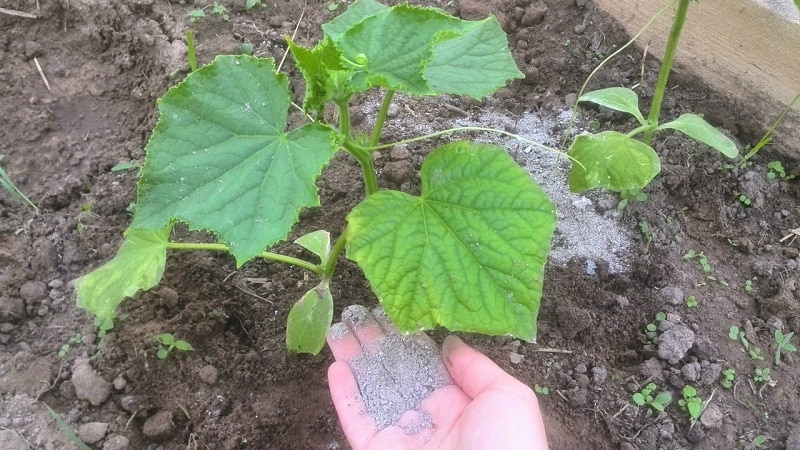
Ash contains dozens of useful microelements. The most important are phosphorus and potassium. They contribute to the development of a strong root system and the formation of a large number of ovaries. That's why feeding with ash used by most gardeners.
When planting plants, fertilizer is applied for the first time. To do this, pour a handful of ash into each hole.
Then the beds are watered with an ash solution twice a season. To prepare it, take 1 kg of fertilizer per bucket of water. The mixture is infused for 24 hours. The resulting infusion is fed to the plants, using 1-2 liters per bush.
Manure

Manure and bird droppings are the most popular fertilizers among gardeners. They contain many beneficial substances and do not contain live weed seeds. It is important to remember that such fertilizers contain a large amount of nitrogen. They are applied 1-2 times per season. Otherwise, the plants will produce a lot of greenery, but few fruits.
Clean manure and chicken droppings cannot be entered.
Infusions are prepared from them, which reduce the concentration of the composition:
- Bovine or horse manure. Dilute with water in a ratio of 1:4. The mixture is infused for 4 days, stirring it periodically. Then the resulting composition is diluted with water in a ratio of 1:10. 1 liter of fertilizer is poured under each bush.
- Chicken droppings. The fertilizer is diluted with water in a ratio of 1:10. The mixture is infused for 24 hours. 1 liter of infusion is poured under each bush.
Often additional components are added to such fertilizer. For example, 35 g of superphosphate per bucket of infusion and 1 tbsp. ash. This saturates the fertilizer with essential potassium and phosphorus.
Green fertilizers
Compost and humus are always used to enrich the soil composition. They contain all the necessary nutritional elements and are ideal for melons.
Fertilizers are applied for the first time in the fall, long before planting. Up to 6 kg of humus or compost is buried per 1 m².
Compost and humus are prepared from weeds and food waste. They are placed in one pile, where the fertilizer rots, turning into a nutrient substrate.
To prepare liquid fertilizer, 1 kg of humus is diluted in 10 liters of water. For 1 plant use 1 liter of solution.
Yeast and beer
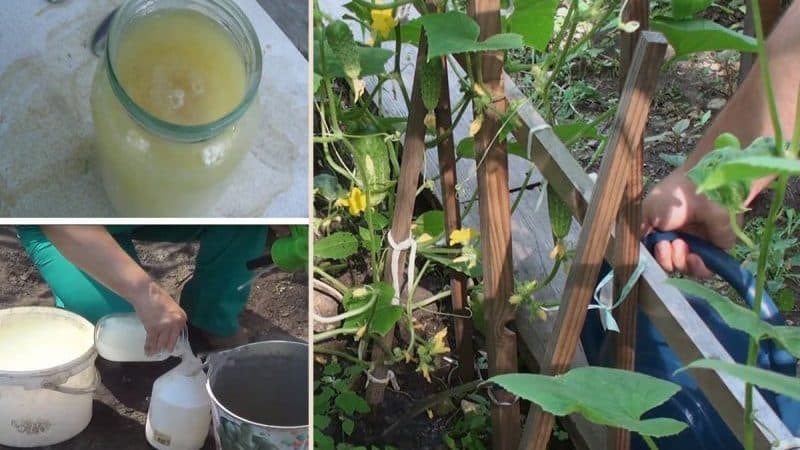
Yeast contains large amounts of nitrogen. They stimulate plant growth and protect them from pests.
To prepare the fertilizer, add a package of “wet” yeast and 1 tbsp to 10 liters of water at room temperature.jam or sugar. The mixture is allowed to brew for 3 days.
0.5 liters of fertilizer are used for each plant. Fertilizing is applied once per season, when the soil warms up.
They also prepare fertilizer from beer. To do this, 1 liter of live beer is diluted in 10 liters of water. 1 liter of infusion is poured under 1 bush.
Onion peel
Onion peels contain vitamins and beneficial microelements, including phosphorus and potassium. This fertilizer is used for application at the root and spraying of plants.
To prepare the product, boil 1 tbsp in 1.5 liters of water. onion peel for 5 minutes. The resulting concentrate is poured into 5 liters of water. 1 liter of fertilizer is used for 1 plant.
Herbal infusions and decoctions
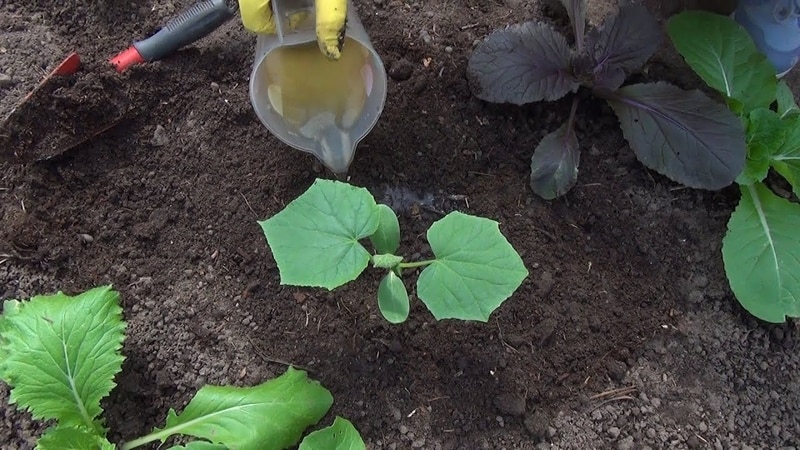
Herbal infusions are good because weeds become the raw materials for their preparation. This tool does not require any financial costs. It is easy to prepare at any time. This is a complex mineral-organic fertilizer that is suitable for any feeding.
To prepare fertilizers, collected plants without signs of disease are cleared of seeds and roots. They fill any container 2/3 full. The remaining amount is poured with warm water. The mixture is left to ferment for 2 weeks.
1 liter of the resulting infusion is diluted with 10 liters of water. Under each bush, pour 1 to 2 liters of the mixture.
Advice! The most useful plant for preparing such fertilizing is considered to be nettle.
Acetylsalicylic acid
Aspirin, or acetylsalicylic acid, is another feeding option. It not only has a positive effect on the development of cucumbers, but also protects them from fungal infections.
To prepare the fertilizer, just dissolve 1 tablet in 1 liter of water. This amount is enough to water 1 plant.
Food waste
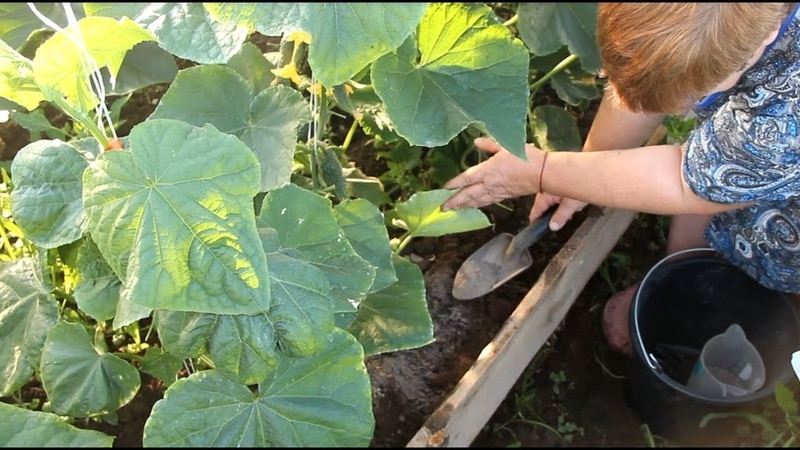
Fertilizers are prepared from them, saturated with all the necessary components for the development of cucumbers:
- One method of preparing fertilizer is to use banana peels.. It contains a large amount of potassium necessary for cucumbers. The recipe for preparing top dressing is simple. To do this, just pour 5 banana skins into 5 liters of beer. The product is infused for 3 days. Then it is diluted with a rein in a 1:1 ratio and used for watering.
- Egg shell fertilizer is another popular way to use food scraps for cucumbers. To prepare it, the shells of 6 eggs are crushed and poured with boiling water. The product is infused for a week, stirring regularly. Fertilizer is used for seedlings.
- Potato peel also suitable for preparing top dressing. Fill 1/3 of the bucket with waste. The rest of the volume is poured with boiling water and left for a week. The resulting product is diluted with water in a ratio of 1:5. 1 liter of fertilizer is poured under 1 bush.
Many gardeners use a mixture of food scraps. Any vegetable peelings and eggshells will do.
Aloe
Aloe is an excellent growth stimulator for cucumber seeds. With its help, the first shoots will appear much faster, and the plants will be more hardy and strong.
To prepare the fertilizer, aloe juice is diluted with water in a 1:1 ratio. The planting material is soaked in the resulting composition for 12 hours before sowing.
Iodine and milk
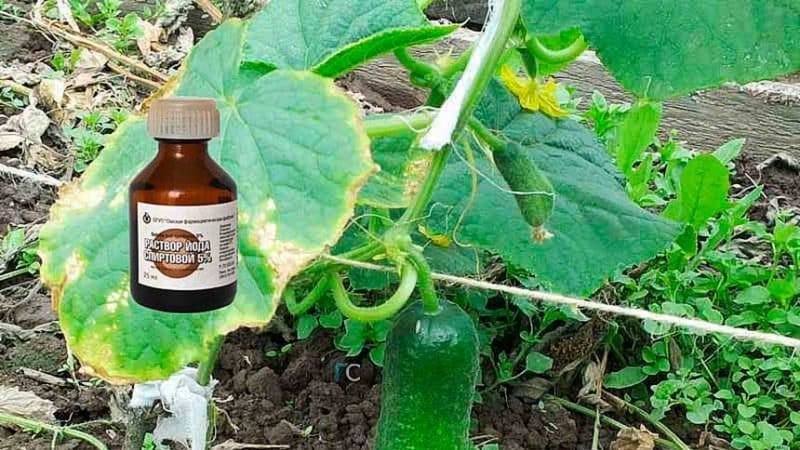
Iodine with milk strengthens the immunity of plants and activates their growth. This remedy also has a powerful antifungal effect. It is used for watering and spraying plants.
To prepare the fertilizer, pour 1 liter of milk or whey and 30 drops into a bucket of water. iodine. The rest of the volume is added with ordinary water at room temperature.
Conclusion
Homemade fertilizers for cucumbers are much safer than store-bought preparations. They do not contain chemicals that negatively affect the environment and safety of the crop.
Folk recipes for fertilizing involve the use of ash, compost and cheap food waste. They show excellent results increasing the quality and quantity of the harvest and increasing plant endurance.